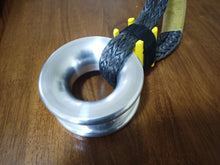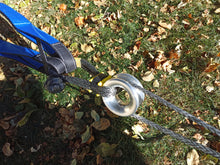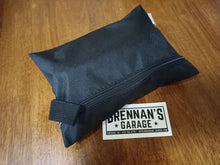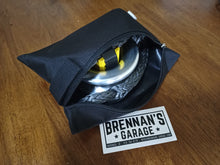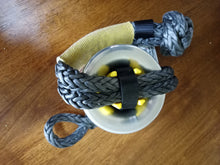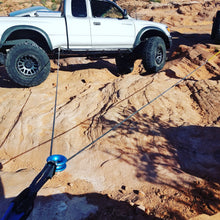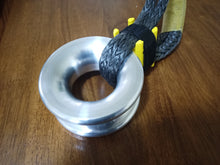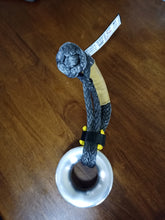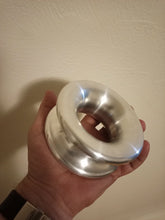
Oct 2025 - In Stock! Unfortunately, Aluminum prices have gone up significantly in the USA with all the recent manufacturing pressure and the new price reflects that change for this batch. I hope we see some relief in the future, but this is still one of the best complete setup values in the industry. I have been using a clear PVC grid style zippered bag on current orders to make identification of the bad contents easier.
Recovery Ring Package.
I am happy to announce that I will be adding this item to standard inventory. For a few years now I have been testing and refining this concept while providing these packages for friends and close customers. I see it is gaining traction in the off-road market now and I want people to have a resource for a complete kit with all the bugs worked out.
My kit includes the following.
Qty 1 - 4.5" dia x 2" thick 6061-T6 CNC custom machined Recovery Ring
Qty 1 - Soft shackle, 7/16 SK78 Dyneema (with fire hose guard)
Qty 1 - Anti-Tip Block, 3d printed, Yellow extra thick wall PLA+ with high infill
Qty 1 - Clear PVC Storage Case, Zippered
Technical Info
Weight: 1.9lbs
The Low Friction ring is a custom CNC manufactured from 6061-T6 aluminum with a polished finish and a light bee's wax protective coating . This part has a Working Load Limit in excess of 25,000lbs and an average minimum breaking strength above 120,000lbs. This new ring has been designed with every critical detail such as a better working radius for up to 5/8" winch lines, a 'self-balancing' loaded radius, and softer edge radii on all corners. The center hole in the ring is also large enough to allow for storage of the included block while still being able to fit entirely in the provided storage bag.
This low friction ring concept has been around for a long time in the competitive sailing world and was widely adopted by the arborist industry shortly after. This concept works perfectly in the recreational off-road market where low weight high strength synthetic winch lines are becoming very common. The low friction recovery ring is intended to replace the traditional heavy and cumbersome steel sheave block or snatch block concept with a lighter safer alternative.
A traditional steel snatch block usually weighs 6-8lbs in the recreational off-road market. In contrast the snatch ring concept weighs only 2lbs while including a completely closed connection to the anchor point. Even if the low friction ring was to fail, the working and anchor lines create a closed system to increase safety.
When I first started testing this concept it was clear that there where going to be some challenges along the way. This is different. Just as people where, and frankly still are, hesitant of synthetic winch lines in general, this technology is new and different in the recreational off-road market.
The first issue that needed to be overcome was what I call 'ring-tip'. The low friction ring will rotate with gravity and spit out the line if the tension in the system changes. In a perfect world and the parking lot this might not happen, but in the real world a winch recovery is rarely maintains consistent tension. It is important to have a way to keep the line locked into the ring as tension changes. I invented what I call the 'Anti-Tip Block' to solve this issue. This block is a small 3d printed device that uses a replaceable 3/4" wide velcro strap to keep keep the ring from being able to rotate which can spit out the rope. The block also has the added benefits of separating the legs of the soft shackle to keep any wear even between them. The height of the block also helps eliminate any extra friction on the outside edges of the ring.
I have found that an 'improved' soft shackle design is the best to use with this system. Having the two independent legs of the shackle spreads out the bearing forces between the ring and shackle as evenly as possible. With over designs of soft shackles where the legs are inside each other, all the wear will be concentrated on one leg. With the two leg design you can manage and alternate any wear on the legs.
One of the most common questions I get is how much wear will there be between the soft shackle and ring? The best answer I can give is that you will have 'some'. The ring actually rotates with the winch line under high load. The soft shackle UHMWPE material has a very low friction coefficient on the smooth aircraft aluminum coating to provide the bearing surface. Personally, I have been using the same soft shackle through all my testing over the last two years and it shows virtually no wear in the bearing surface interface. The best thing you can do to limit wear and increase life is give things a bath in clean clear water and let them air dry after use.
One big lesson I learned along the way is that the normal nylon wear sleeves used on most soft shackles do NOT make a good bearing surface for the low friction ring. The coefficient of friction on nylon is typically higher and the sleeves will actually rotate on the soft shackle causing damage. I do included a standard nylon wear sleeve in the bags kit, but it is only intended to be used if the soft shackle is being used for normal static rigging if you just have to have another soft shackle in an emergency.
Why isn't the Recovery Ring coated or anodized? The short version is that it shouldn't be. The lowest friction between UHMWPE and the ring will be with a polished aluminum surface. Anodizing and laser etching can produce a textured surface that ends up being on critical surface areas, not to mention adding a significant amount of cost. You can feel those micro imperfections with your finger. The polished aluminum surface will provide a longer life for the synthetic rigging, and is also the easiest to repair over the life of the device. If the device suffers a ding during use, it can easily be repaired using a small fine file and polished. This device is not going to live its entire life static out in the elements. Most of it's life will be sitting in the included protective case safely tucked away waiting for when it can help save your day. The only required maintenance is a dunk in clean water along with a physical 'touch' inspection for any dings, finally a light wipe down with some good quality car wax.








